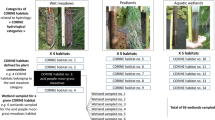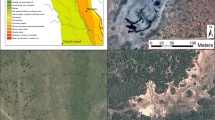Abstract
The main goal of this study was to assess if the soils of wetlands of different condition varied in terms of element composition. The rationale was that compared to wetlands of good condition, wetlands of poor condition—which in the region have typically been disturbed by agricultural activities, are lower in biodiversity and have fewer native species—would have been altered in their physical and chemical soil characteristics. This in turn would have altered the element composition of the soils. The concentrations of about 50 elements in the topsoil of 43 seasonal wetlands of varying condition, as measured by plant community based assessments, across North Dakota were determined. Organic matter content of the soils increased as condition increased, and it was the most important variable explaining 40 % of variation in the concentrations of elements. This can be partly explained by binding of elements to organic matter (S, Se) and for most other elements (that bind mostly to the inorganic fraction) by displacement by organic matter. The biogeochemistry of S is further implicated in the distribution of Ca, most likely via formation of insoluble gypsum (calcium sulfate).










Similar content being viewed by others
References
Arndt, J. L., & Richardson, J. L. (1988). Hydrology, salinity and hydric soil development in a North Dakota prairie-pothole wetland system. Wetlands, 8, 93–108. doi:10.1007/BF03160595.
Arndt, J. L., & Richardson, J. L. (1989). Geochemistry of hydric soil salinity in a recharge-throughflow-discharge prairie-pothole wetland system. Soil Science Society of America Journal, 53, 848–855. doi:10.2136/sssaj1989.03615995005300030037x.
Bresler, E., McNeal, B. L., & Carter, D. L. (1982). Saline and sodic soils. Advanced series in agricultural sciences 10 (p. 236). Berlin, Heidelberg, New York: Springer Verlag.
Brubaker, S. C., Jones, A. J., Lewis, D. T., & Frank, K. (1993). Soil properties associated with landscape position. Soil Science Society of America Journal, 57, 235–239. doi:10.2136/sssaj1993.03615995005700010041x.
Cihacek, L.J., Franzen, D.W., Seaholm, J., Swenson, L.J., Johnson, A., Gunderson, J. & Dahnke, W.C. (2009). Summary of Soil Fertility Levels for North Dakota, 1991-2001. NDSU Extension Service, North Dakota State University, Fargo, ND. Document nr. SF-1397. http://www.ag.ndsu.edu/pubs/plantsci/soilfert/sf1397.pdf.
Combs, S.M. & Nathan, M.V/ (2012). Soil Organic matter. In: Recommended Chemical Soil Test Procedures for the North Central Region. Missouri Agricultural Experiment Station SB 1001. North Central Regional Research Publication No. 221 (Revised). Chapter 12. Pp. 12.1-12.6. http://extension.missouri.edu/explorepdf/specialb/sb1001.pdf.
Dahl, T.E. (2014). Status and Trends of Prairie Wetlands in the United States 1997 to 2009. U.S. Fish and Wildlife Service. Washington D.C. http://www.fws.gov/wetlands/Documents/Status-and-Trends-of-Prairie-Wetlands-in-the-United-States-1997-to-2009.pdf.
Ellis, S., & Mellor, A. (1995). Soils and environment. London, New York: Routledge.
Euliss, N. H., LaBaugh, J. W., Fredrickson, L. H., Mushet, D. M., Laubhan, M. K., Swanson, G. A., Winter, T. C., Rosenberry, T. C., & Nelson, R. D. (2004). The wetland continuum: a conceptual framework for interpreting biological studies. Wetlands, 24, 448–458. doi:10.1672/0277-5212(2004)024[0448:TWCACF]2.0.CO;2.
Galatowitsch, S. M., Whited, D. C., Lehtinen, R., Husveth, J., & Schik, K. (2000). The vegetation of wet meadows in relation to their land-use. Environmental Monitoring and Assessment, 60, 121–144. doi:10.1023/A:1006159028274.
Garrett, R.G. (1994). The distribution of cadmium in a horizon soils of Canada and adjoining United States. Current Research 1994B: Interior Plains and Arctic Canada. Geological Survey of Canada, 73-82. http://ftp2.cits.rncan.gc.ca/pub/geott/ess_pubs/193/193646/cr_1994_b.pdf.
Gilbert, M.C., Whited, P.M., Clairain, Jr. E.J. & Smith, R.D. (2006) A regional guidebook for applying the hydrogeomorphic approach to assessing wetland functions of prairie potholes. U.S. Army Engineer Research and Development Center, Vicksburg, MS. Publication ERDC/EL TR-06-5. http://el.erdc.usace.army.mil/elpubs/pdf/trel06-5.pdf.
Gleason, R.A. & Euliss, N.H. Jr. (1998). Sedimentation of Prairie Wetlands. Great Plains Research, 8, 97-112. http://digitalcommons.unl.edu/cgi/viewcontent.cgi?article=1365&context=greatplainsresearch.
Goldhaber, M. B., Mills, C. T., Morrison, J. M., Stricker, C. A., Mushet, D. M., & LaBaugh, J. W. (2014). Hydrogeochemistry of prairie pothole region wetlands: role of long-term critical zone processes. Chemical Geology, 387, 170–183. doi:10.1016/j.chemgeo.2014.08.023.
Grossman, J.N., Grosz, A.E., Schweitzer, P.N., Schruben, P.G. (2004). The National Geochemical Survey—Database and Documentation. U.S. Geological Survey Open-File Report 2004-1001. http://mrdata.usgs.gov/geochem/doc/home.htm
Hargiss, C.L.M. (2009). Estimating wetland quality for the Missouri Coteau ecoregion in North Dakota. PhD Dissertation, North Dakota State University, Fargo, ND. http://search.proquest.com/docview/304961553
Hargiss, C. L. M., & DeKeyser, E. S. (2014). The challenges of conducting environmental research on privately owned land. Environmental Monitoring and Assessment, 186, 979–985. doi:10.1007/s10661-013-3432-8.
Hargiss, C. L. M., DeKeyser, E. S., Kirby, D. R., & Ell, M. J. (2008). Regional assessment of wetland plant communities using the index of plant community integrity. Ecological Indicators, 8, 303–307. doi:10.1016/j.ecolind.2007.03.003.
Heagle, D., Hayashi, M., & Van der Kamp, G. (2013). Surface–subsurface salinity distribution and exchange in a closed-basin prairie wetland. Journal of Hydrology, 478, 1–14. doi:10.1016/j.jhydrol.2012.05.054.
Holmgren, G. G. S., Meyer, M. W., Chaney, R. L., & Daniels, R. B. (1993). Cadmium, lead, zinc, copper, and nickel in agricultural soils of the United States of America. Journal of Environmental Quality, 22, 335–348. doi:10.2134/jeq1993.00472425002200020015x.
Horowitz, A. J., & Elrick, K. A. (1987). The relation of stream sediment surface area, grain size and composition of trace element chemistry. Applied geochemistry, 2, 437--451. doi:10.1016/0883-2927(87)90027-8
Jacob, D. L., & Otte, M. L. (2003). Conflicting processes in the wetland plant rhizosphere: metal retention or mobilization? Water, Air and Soil Pollution, Focus, 3, 91–104. doi:10.1023/A:1022138919019.
Jacob, D. L., Otte, M. L., & Hopkins, D. G. (2011). Phyto (In)stabilization of elements. International Journal of Phytoremediation, 13, 34–54. doi:10.1080/15226514.2011.568535.
Jacob, D. L., Yellick, A. H., Kissoon, L. T., Asgary, A., Wijeyaratne, D. N., Saini-Eidukat, B., & Otte, M. L. (2013). Cadmium and associated metals in soils and sediments of wetlands across the Northern Plains, USA. Environmental Pollution, 178, 211–219. doi:10.1016/j.envpol.2013.03.005.
Johnson, W. C., Boettcher, S. E., Poiani, K. A., & Guntenspergen, G. (2004). Influence of weather extremes on the water levels of glaciated prairie wetlands. Wetlands, 24, 385–398.
Jokic, A., Cutler, J. N., Ponomarenko, E., van der Kamp, G., & Anderson, D. W. (2003). Organic carbon and sulphur compounds in wetland soils: insights on structure and transformation processes using K-edge XANES and NMR spectroscopy. Geochimica et Cosmochimica Acta, 67, 2585–2597. doi:10.1016/S0016-7037(03)00101-7.
He, Z. L., Yang, X. E., & Stoffella, P. J. (2005). Trace elements in agroecosystems and impact on the environment. Journal of Trace Elements in Medicine and Biology, 19, 125–140. doi:10.1016/j.jtemb.2005.02.010.
Kantrud, H.A., Krapu, G.L. & Swanson, G.L. (1989). Prairie basin wetlands of the Dakotas: a community profile. US Fish and Wildlife Service Biological Report 85 (7.28). http://www.nwrc.usgs.gov/techrpt/85-7-28.pdf.
Kissoon, L. T., Jacob, D. L., & Otte, M. L. (2010). Multi-element accumulation near Rumex crispus roots under wetland and dryland conditions. Environmental Pollution, 130, 337–345. doi:10.1016/j.envpol.2009.11.001.
Kissoon, L. T., Jacob, D. L., & Otte, M. L. (2011). Multiple elements in Typha angustifolia rhizosphere and plants: wetland versus dryland. Environmental and Experimental Botany, 72, 232–241. doi:10.1016/j.envexpbot.2011.03.010.
LaBaugh, J. W., Winter, T. C., & Rosenberry, D. O. (1998). Hydrologic functions of prairie wetlands. Great Plains Research, 8, 17–37.
Lopez, R.D. & Fennessy, M.S. (2002). Testing the Floristic Quality Assessment Index as an indicator of wetland condition. Ecological Applications, 12, 487–497. doi: 10.1890/1051-0761(2002)012[0487:TTFQAI]2.0.CO;2 doi:10.1890/1051-0761(2002)012%5b0487:TTFQAI%5d2.0.CO;2
Markert, B. (1996). Instrumental element and multi-element analysis of plant samples—methods and applications (p. 296). Chichester, UK: John Wiley & Sons.
Markert, B., Fränzle, S., & Wünschmann, S. (2015). Chemical evolution—the biological system of the elements. Cham, Switzerland: Springer.
Martin, D. B., & Hartman, W. A. (1984). Arsenic, cadmium, lead, mercury, and selenium in sediments of riverine and pothole wetlands of the north central United States. Journal of the Association of Analytical Chemists, 67, 1141–1146.
Mason, J. (2012). Bakken's maximum potential oil production rate explored. Oil and Gas Journal, 2 April 2012, http://www.ogj.com/articles/print/vol-110/issue-4/exploration-development/bakken-s-maximum.html, accessed 24 August 2015.
Miller, S.J., Wardrop, D.H., Mahaney, W.M. & Brooks, R.P. (2006). A plant-based index of biological integrity (IBI) for headwater wetlands in central Pennsylvania. Ecological Indicators, 6, 290–312. doi:http://dx.doi.org/10.1016/j.ecolind.2005.03.011 doi:10.1016/j.ecolind.2005.03.011#doilink
Mitsch, W. J., & Gosselink, J. G. (2015). Wetlands (5th ed.). New York: Wiley.
Mushet, D.M., Euliss, N.H. Jr. & Schaffer, T.L. (2002). Floristic Quality Assessment of one natural and three restored wetland complexes in North Dakota, USA. Wetlands, 22, 126-138. Doi: http://dx.doi.org/%2010.1672/0277-5212(2002)022%5b0126:FQAOON%5d2.0.CO;2
Niemuth, N., Wangler, B., & Reynolds, R. E. (2010). Spatial and temporal variation in wet Area of Wetlands in the Prairie Pothole Region of North Dakota and South Dakota. Wetlands, 30, 1053–1064. doi:10.1007/s13157-010-0111-1.
Niskavaara, H., Reimann, C., Chekushin, V., & Kashulina, G. (1997). Seasonal variability of total and easily leachable element contents in topsoils (0-5 cm) from eight catchments in the European Arctic (Finland, Norway and Russia). Environmental Pollution, 96, 261–274. doi:10.1016/S0269-7491(97)00031-6.
Preston, T. M., Sojda, R. S., & Gleason, R. A. (2013). Sediment accretion rates and sediment composition in Prairie Pothole wetlands under varying land use practices, Montana, United States. Journal of Soil and Water Conservation, 68, 199–211. doi:10.2489/jswc.68.3.199.
Reddy, K. R., & DeLaune, R. D. (2008). Biogeochemistry of wetlands: science and applications. Boca Raton, FL, USA: CRC Press.
Reimann, C., Boyd, R., de Caritat, P., Halleraker, J. H., Kashulina, G., Niskavaara, H., & Bogatyrev, I. (1997). Topsoil (0-5 cm) composition in eight arctic catchments in northern Europe (Finland, Norway and Russia). Environmental Pollution, 95, 45–56. doi:10.1016/S0269-7491(96)00102-9.
Reimann, C., Kashulina, G., de Caritat, P., & Niskavaara, H. (2001). Multi-element, multi-medium regional geochemistry in the European arctic: element concentration, variation and correlation. Applied Geochemistry, 16, 759–780. doi:10.1016/S0883-2927(00)00070-6.
Reimann, C., Filtzmoser, P., Garrett, R., & Dutter, R. (2008). Statistical data analysis explained. Applied environmental statistics with R. Chichester, UK: John Wiley & Sons.
Salomons, W., & Förstner, U. (1984). Metals in the hydrocycle. Berlin, Germany: Springer-Verlag.
Shacklette, H.T. & Boerngen, J.G. (1984). Element concentrations in soils and other surficial materials of the conterminous United States. United States Geological Survey professional paper 1270. http://pubs.usgs.gov/pp/1270/pdf/PP1270_508.pdf.
Smith, D.B., Cannon, W.F., Woodruff, L.G., Garrett, R.G., Klassen, R., Kilburn, J.E., Horton, J.D., King, H.D., Goldhaber, M.B. & Morrison, J.M. (2005). Major- and trace element concentrations in soils from two continental-scale transects of the United States and Canada. US Geological Survey. Open-File Rep. #1253. http://pubs.usgs.gov/of/2005/1253/.
Spurgeon, D. J., Rowland, P., Ainsworth, G., Rothery, P., Lond, S., & Black, H. I. J. (2008). Geographical and pedological drivers of distribution and risks to soil fauna of seven metals (Cd, Cu, Cr, Ni, Pb, V and Zn) in British soils. Environmental Pollution, 153, 273–283. doi:10.1016/j.envpol.2007.08.027.
Tabatabai, M. A. (2005). Chemistry of sulfur in soils. In M. A. Tabatabai & D. L. Sparks (Eds.), Chemical processes in soils (pp. 193–226). Madison, WI, USA: Soil Science Society of America.
ter Braak, C. J. F., & Šmilauer, P. (2002). CANOCO reference manual and CanoDraw for Windows user’s guide. Wageningen, The Netherlands: Biometris, Wageningen University and Research Center.
The Northern Great Plains Floristic Quality Assessment Panel (2001). Coefficients of conservatism for the vascular flora of the Dakotas and adjacent grasslands. Federal Government Series: Information and Technology Report - 2001-0001, U.S. Geological Survey, Biological Resources Division, Information and Technology Report USGS/BRD/ITR. http://pubs.er.usgs.gov/publication/itr20010001
Wiken, E., Jiménez Nava, F. & Griffith, G. (2011). North American Terrestrial Ecoregions Level III. Commission for Environmental Cooperation, Montreal, Canada. http://www3.cec.org/islandora/en/item/10415-north-american-terrestrial-ecoregionslevel-iii-en.pdf.
Winter, T.C. (2003). Ed. Hydrological, chemical, and biological characteristics of a prairie pothole wetland complex under highly variable climate conditions: the Cottonwood Lake area, east-central North Dakota. USGS Professional Paper 1675. http://pubs.er.usgs.gov/publication/pp1675.
Acknowledgements
This project was supported by grants from the US Environmental Protection Agency (EPA/ND Department of Health Wetland Program Development Grant, National Center for Research Resources (5P20RR016471-1), from the North Dakota Agriculture Experiment Station/NDSU College of Science and Mathematics small grants program, and from an NIH grant (number P20 RR016471) from the INBRE program of the National Institute of General Medical Sciences. Thanks to Steph Longstaff Hummel for help with Fig. 1. Special thanks also to reviewers for their very helpful advice.
Author information
Authors and Affiliations
Corresponding author
Electronic supplementary material
Below is the link to the electronic supplementary material.
Supplementary Materials Table S1
(XLSX 18 kb)
Supplementary Materials Table S2
(XLSX 98 kb)
Supplementary Materials Table S3
(XLSX 29 kb)
Supplementary Materials Table S4
(XLSX 24 kb)
Rights and permissions
About this article
Cite this article
Yellick, A.H., Jacob, D.L., DeKeyser, E.S. et al. Multi-element composition of soils of seasonal wetlands across North Dakota, USA. Environ Monit Assess 188, 17 (2016). https://doi.org/10.1007/s10661-015-5013-5
Received:
Accepted:
Published:
DOI: https://doi.org/10.1007/s10661-015-5013-5




